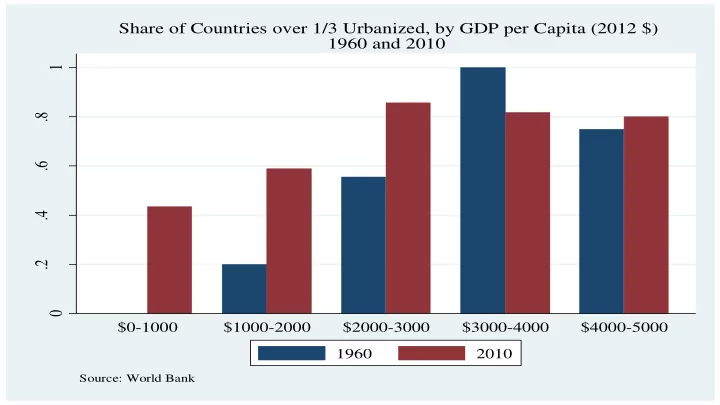

Share of Countries over 1/3 Urbanized, by GDP per Capita (2012 $) 1960 and 2010 1 .8 .6 .4 .2 0 $0-1000 $1000-2000 $2000-3000 $3000-4000 $4000-5000 1960 2010 Source: World Bank
Per Capita GDP Growth 1960-2010 (Poor Countries<$5000 PC GDP) 3 Korea, Rep. Singapore Japan Spain Hong Kong SAR, China Portugal 2 Brazil China Greece Thailand Malaysia Mexico Dominican Republic Colombia Uruguay Congo, Rep. Chile Peru Costa Rica Panama 1 Turkey Algeria Egypt, Arab Rep. Ecuador South Africa Sri Lanka India Morocco Sudan Syrian Arab Republic El Salvador Pakistan Rwanda Honduras Papua New Guinea Bolivia Jamaica Guatemala Nicaragua Iraq Nepal Cameroon Philippines Uganda Afghanistan Kenya Bangladesh Benin Malawi Cote d'Ivoire 0 Ghana Togo Cambodia Central African Republic Zambia Senegal Burundi Sierra Leone -1 Niger Zimbabwe Liberia -2 Congo, Dem. Rep. 0 .2 .4 .6 .8 1 Urbanization in 1960
11 10 9 8 7 6 0 .2 .4 .6 .8 1 % Urbanization, 2010 Log of P.C. GDP 2010 PPP Fitted values
Outline of Talk: Good and Bad of Cities • Do the same factors that predict success in the wealthy world also hold for three large developing countries? • Computer vision techniques for measuring income, infrastructure and assessing housing prices. • Dealing with the downsides of density. • A broad lesson: Cities are about interactions and hence institutions – like rule of law – that govern interactions are particularly critical in cities. • CITIES AND RULE OF LAW ARE COMPLEMENTS.
Per Capita GDP 2010 . 100000 San Jose 80000 oSan Fran o Boston o New York 60000 o o o o o o o o o o o o o o o o o o o Atlanta o o o o o o o o o o o o o o o o o Detroit o Las Vega o o o o o o 40000 o o o o o o o o o oo o o o o o o o o o Bakersfi o o o o o o oo o 20000 o .1 .2 .3 .4 .5 Share of Adults with B.A.s 2000
Average Population Growth by Share with BA in 2000 (Quintiles) .15 .1 .05 0 1 2 3 4 5
Measuring Streetscapes (with Nikhil Naik)
Predicting Income from Imagery Proof-of-concept experiment for the U.S. Median Income of the Census Block group: $60,000
Training Examples $74,000 Machine Learning Predicted Income $38,000 $18,000 Image Features Derived from Pixels $54,000
Training Sample – New York Income R^2 = 0.85
Testing Sample – New York Income R^2 = 0.81
Test: New York City R^2 = 0.81 Test: Boston R^2 = 0.86
Chinitz: Contrasts in Agglomeration: New York and Pittsburgh
Economic Growth and Firm Size MSA Employment Growth (1977-2010) by Average Firm Size (1977) Quintiles 2 1.5 1 .5 0 1 2 3 4 5 Smallest firms are in Quintile 1
A Trio of Failures: Politics, Public Management, Law • Public Management Failures means that the projects are poorly performed and corruption and waste are rife. • Economics of Corruption, Public Private Partnerships • Legal failures mean that private property is unsafe and that it is impossible to deal with the negative externalities with effective incentives. • Economics of Crime, Law and Economics • Political failures means the wrong projects (or no projects) get built – the direction of policy is wrong. • Political Economy
Public Management Failure: Tweed’s Infamous Courthouse
Political Failures: Detroit’s Infamous People Mover
A Tale of Two Technologies • Many urban services can be provided by a cheap individual technology and a (socially if not privately) costly shared technology: • Sewage system vs. Pit Latrine • Shallow Well vs. Aqueducts and Piped Water • Jitneys vs. Public BRT/Rail System • Also cheap private schools, private secturity, etc. • We focus on cases where the individual option generates negative externalities, which means that there is a case for inducing adoption of the collective technology.
A Tale of Two Technologies Gautrain by Habib M’henni
The Last Mile Problem in Zambia • 1975-1983, the World Bank had provided Zambia with $20 million for Lusaka Squatters • Plan for upgrading 26,000 households (with access to communal taps – like NYC hydrants). • Households applied for water, but not sewers. • Externalities are a larger share of benefit for sewers • Cost of connection is about $960 – high relative to incomes. • Massive infrastructure program has had far too little impact because of non- adoption. • Unclear ownership reduces incentive to invest. • Public sector has a strong anti-subsidy bent. • But they don’t really want to impose penalties either. • Current fees are typically not collected (10% in one study).
Executive vs. Judicial Incapacity
Property Rights and Urban Governance • Ownership entails responsibilities. With ownership comes the ability to fine for not taking actions that create social costs. • Ownership also creates the possibility for property taxes. • Use computer vision techniques for mass appraisal. • But demand for titling in a world where property rights remain uncertain often seems week. • How to predict prices with computer vision techniques.
World Justice Project Survey Data
.2 India Mali Ghana South Africa .1 Moldova Guatemala Mexico Rwanda Poland Sweden Malaysia France Finland Indonesia Romania Russian Federation Brazil United Kingdom Egypt, Arab Rep. Slovenia 0 Japan Morocco Australia Norway Bulgaria United States Canada Germany Netherlands Ukraine Cyprus Spain Argentina Italy Uruguay New Zealand Iraq -.1 Thailand 4 6 8 10 12 Log of Per Capita GDP
Recommend
More recommend